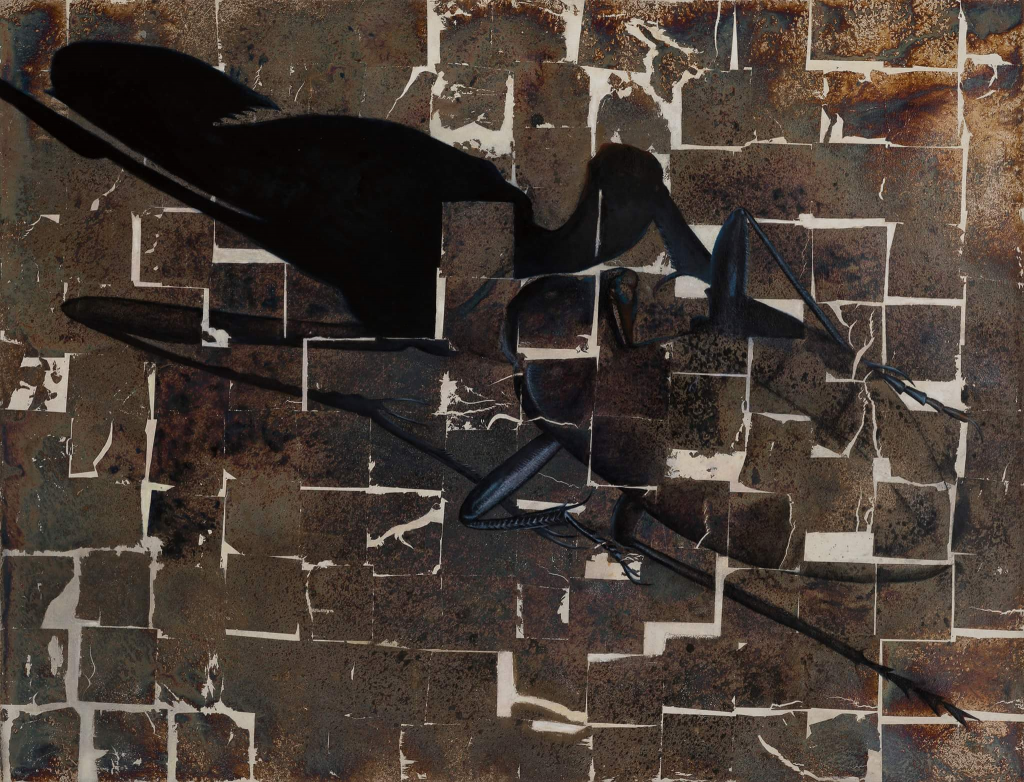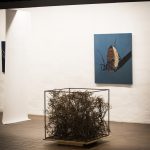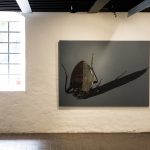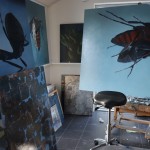Residuum – something remaining
The fact that the human imprint on our environment is substantial and adverse is often addressed. In the series Residuum – something remaining the focus is on beetles, or rather the armor-like exoskeletons that protect their soft, vulnerable bodies and remain intact after the death and decomposition of the organism. Different types of beetles are depicted individually on the large, night-dark canvases, their shadows grounding them in an otherwise free-floating state.
Despite the beautiful and delicate rendering of the insects and the dreamy calmness, their long shadows give each portrait an ominous and desolate character, and the low light source, perhaps indicating a setting sun, adds a sense of impending doom.
According to several scientific reviews, the rate of insect extinction is accelerating at an alarming speed; by depicting the empty remains, Udsen shines a harsh light on the vulnerability of not only insects, but entire ecosystems that fall victim to negative human impact. By taking a small, almost invisible part of nature and magnifying it to a scale where the only option is to experience it, Udsen venerates the inextricably interwoven web of life, which we are all part of.
Text af kunsthistoriker Lise Johanne Sinnbeck
“I have painted the remainings of a beetle. It is the beetle shell, the skeleton, that is left to emerge with the cycle of nature that fascinate me. I have tried to enlarge a part of nature that normally never catches our eye. Gliding transitions and subtle changes move between figurative and abstract. We continue to destroy our climate through increased CO2 emissions. We eradicate insects and other hardly visible creatures, that make our lives possible. We talk a lot about living in an anthropocene age, a world shaped by humans. But the naturalist and environmentalist, E.O. Wilson, has suggested another name, eremocine, the age of loneliness. The loss of pollinating insects has drastically increased in recent years and now we notice the loss. A reduction we cannot see with the naked eye. I wonder if future expeditions in nature will be just as fascinating for coming generations?”
“In the poem Gläntan, the Swedish poet Tomas Tranströmer describes the beetle as a poetic revelation, lying on the earth with a shining shield, illuminated by the sun. Tranströmer himself was an avid collector of beetles and he was engaged in capturing the significance of the beetle as the subject of universal depictions of man’s bond with nature.”
Text af kunsthistoriker Anne Maria Udsen
Svensk
I serien Residuum – something remaining målar jag insektens kvarlåtenskap. Det är skalbaggens överblivna skal, skelettet, som ligger kvar efter att innehållet återgått till naturens kretslopp, som fascinerar mig.
Jag försöker förstora upp en del av naturen som normalt annars inte fångar vår uppmärksamhet. I dikten Gläntan beskriver poeten Tomas Tranströmer skalbaggen som en poetisk uppenbarelse som ligger på jorden med glänsande sköld och blir upplyst av solen. Tranströmer var själv en ivrig skalbaggssamlare och fångade i sin poesi essensen av skalbaggen och andra naturföreteelser för universella skildringar av människans band med naturen. Serien är en slags modern “Memento mori” som berättar om livets förgänglighet. Fragmenterad och oxiderad bladmetall blandar sig med olja för att ge materialet en extra dimension som berättar om livets förgänglighet och förlust. Det är glidande övergångar och subtila växlingar som rör sig mellan figuration och abstraktion. Vi talar mycket om att leva i en antroposcen tidsålder, en värld som är formad av människor. Men naturalisten och miljökämpen E.O. Wilson har föreslagit ett annat namn, Eremocine, ensamhetens tidsålder. Förlusten av växt – och djurarter har drastiskt ökat de senaste åren och nu märker vi förlusten. En minskning vi inte kan se med blotta ögat. Vi utrotar insekter och andra, för det mesta osynliga, väsen som gör våra liv möjliga. Vi fortsätter ödelägga vårt klimat genom ökade CO₂-utsläpp.
Jag undrar om framtidens expeditioner i naturen kommer att vara lika fascinerande för de kommande generationerna?
Dansk
I serien maler jeg insektets efterladenskaber og forstørrer en del af naturen som normalt ikke fanger vores opmærksomhed. Det er billens skal, skelettet som ligger tilbage efter at indholdet er overgået til naturens kredsløb, som fascinerer mig. Vi taler meget om at leve i den antropocæne tidsalder, en verden som er formet af mennesker, men E.O. Wilson, naturalisten og miljø kæmperen har foreslået et andet navn: Eremocinen, ensomhedens alder. Tabet af vækster og dyrearter har øget drastisk de senere år og nu mærker vi forandringen, som en formindskelse, vi ikke ser med det blotte øje. Vi udrydder insekter og andre for det meste ubemærkede væsener, der gør vores liv mulige. Vi bare fortsætter med at ødelægge vores klima gennem øgede CO2-udslip. Mon barndommens ekspeditioner i naturen vil rumme den samme fascination for de nyere generationer.














